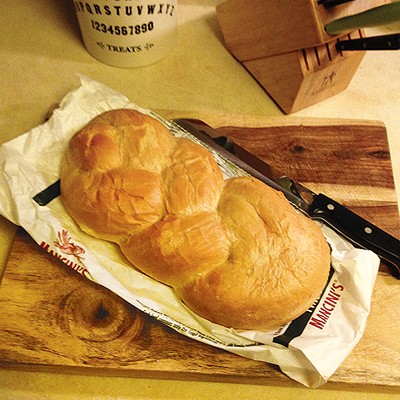Backtracking Through Fall
Scenic railroads offer a nostalgic view of autumn
Theater Listings
Pop Music
Visual Art
Fall Festivals and Special Events
Dance
Fall Film Preview
It used to be we thought nothing of boarding a train -- for commuting or shopping, seeing far-flung relatives, going to the seaside, joining the army, fleeing from the law. But the ascension of the automobile meant the demise of passenger trains, and today only the slimmest network of tracks, administered by Amtrak, remains of the dozens of former lines.
Yet, people still love trains, and think of them fondly. Trains conjure up romance, whether it's the forlorn bleat of its whistle or the relaxed pace of an overland journey, where countryside, not freeway overpasses, whizzes by outside. To sate this desire today there are tourist trains, sometimes called scenic railways. Unlike Amtrak, which provides everyday service designed to move people from city to city, tourist trains don't normally go anywhere of note. The ride itself is the destination, a chance to clamber aboard a vintage passenger car and go clackety-clack for a while.
Currently there are four tourist trains operating within day-trip range of Pittsburgh: Cuyahoga Valley Scenic Railroad and Minerva Scenic Railway, both in Ohio; Western Maryland Scenic Railroad in Cumberland, Md.; and Oil Creek and Titusville Railroad, the last operating tourist train in Western Pennsylvania. These are non-profit ventures that cruise along existing railway lines, offering narrated tours and the chance to enjoy a couple hours of train travel.
Today's tourist railways work to preserve railroading's past, though it's easier to replicate the mid-20th century with its diesel locomotives than the long-ago, seemingly more romantic days of steam engines. Equipment is salvaged: Engines and other cars have been purchased from defunct rail lines; in other cases, the machinery has been donated or loaned. (Ingenuity prevails: The Oil Creek and Titusville Railway acquired a former refrigerator car that had been converted to a flat car. They put in a new floor and waist-high siding, and now run it as their popular open-air gondola car.) Cars are refurbished with fresh paint jobs, interior climate control, new upholstery and snack bars.
Once aboard, the traveler can savor the unique sensory experience that constitutes a train ride -- from the distinctive tang in the air of hot metal to that familiar, comforting lurch. Walking about, one is never too old to feel that small thrill when passing from carriage to carriage: It seems slightly dangerous to feel the outside air, step over the visible machinery holding the cars together, and hear the unmuffled clatter of the wheels against the track.
Like other attractions, these trains are sensitive to the vagaries of economics. Last year, the local Kiski Junction Railroad stopped operating its tourist line through the Kiskiminetas River Valley, citing increased operating costs and a lack of volunteers. The Laurel Highlands Railroad, a steam-train excursion through the Laurel Highland Valley, closed up shop in 2001. State subsidies that have helped support the Western Maryland Scenic Railroad cease this year; later this month the railroad will announce its plans for future operations, which might include limiting the route. In an odd bit of conflicting recreational transportation interests, WMSR must also find a way to safely share a tunnel with the Allegheny Highlands bicycle trail, part of the proposed bike path that will eventually link Pittsburgh and Washington, D.C.
But all four of these regional tourist trains run well into this fall, when a ride through the trees provides an ideal opportunity for enjoying the seasonal foliage. Since autumn is a popular time for train excursions, it is strongly recommended you call ahead for availability and reservations. Plan on being at the station at least 30 minutes before the scheduled departure. You don't want to miss one of the few remaining train rides out there.
NAME: Cuyahoga Valley Scenic Railroad
PHONE: 1-800-468-4070
WEB SITE: www.cvsr.com
SERVICE TO: Various round-trip and extended excursions to nearby attractions along the 51-mile route between suburban Cleveland and Akron.
COST: Fares vary depending on journey. A nearly two-hour, round-trip fall foliage excursion is $14 (adult), $12 (seniors) and $9 (12-and-under). A one-way bike ticket is $9 ($8 seniors, $6 12-and-under).
HOURS: Vary depending on excursion. Sat.-Sun. through September; Wed.-Sun. in October; Sat.-Sun., November through mid-December.
SPECIAL ATTRACTIONS: Halloween Express, Underground Railroad, Wine-Tasting, Christmas Tree Adventure, Santa Express (reservations required for special trains)
PRESIDENTIAL CONNECTION: Coordinated excursions to William McKinley Presidential Library and Museum and First Ladies National Historic Site, both in Akron.
A testament to the success of the Cuyahoga Valley Scenic Railroad, which has run its tourist line since 1972, is the range of trips it offers -- from one-way train-and-bike jaunts to all-day excursions with a nearby museum tossed in. Running for 51 miles between the southern outskirts of Cleveland through the Cuyahoga Valley National Park to Canton, you'd have to make several trips to see all the CVSR offers. But even a short trip gives you an opportunity to enjoy Ohio's largest national park, on-board or off-.
The tracks, which date from the 1880s and once served both passenger and freight lines between Canton and Cleveland, mostly follow the Cuyahoga River and the adjacent Ohio and Erie Canal. The on-board narration alerts us to passing points of interest both natural -- a blue heron rookery, a swamp marked by dead trees that the guide calls a "ghost forest" -- and man-made -- the spot where the paper mill burned down; a couple of Sears Roebuck kit houses, freshly re-painted, that now house offices for the Park Service.
Through the park the journey is quite pastoral; only occasionally through the trees is there a glimpse of the Cleveland suburbs, but even they are leafy around here. But there's no mistaking modern civilization when we pass under the Ohio Turnpike: It looms far, far above -- six lanes of traffic perched high on surprisingly graceful concrete supports.
I had outdoor exercise in mind when I boarded the train at Rockside Station, CVSR's northernmost outpost, for their bike-and-hike trip. From there it's a 35-minute ride to the Peninsula Station, where my bike and I would be discharged and could wheel back to Rockside along a path. Because the CVSR trains run back and forth twice a day, it is also possible to schedule a trip so that you disembark at one spot, enjoy a couple hours rambling about in the well-maintained park (restrooms, water, plenty of benches), and board a later train to return to your automobile.
Since I had chosen to immerse myself in the scenery with the one-way ticket, the bike path leads back to my car. This is a popular trail that easily accommodates cyclists, joggers and hikers -- even the occasional horse. Converted from the old canal towpath, it's wide, flat, covered in crushed limestone -- and an easy cycle, though it's 13 miles back to the Rockside parking lot. I made a slow journey on an old clunker bike with a flat tire, enjoyed frequent stops and a lengthy lunch break, and my return trip took about three hours. Your time may vary, with proper equipment and better stamina.
MINERVA SCENIC RAILWAY
PHONE: 330-868-8814
WEB SITE: www.minervascenicrailway.com
SERVICE TO: Minerva and Bayard via a 6-mile, one-hour round-trip
COST: $10 adults; $5 12-and-under
HOURS: Four trains daily, from 11 a.m. to 3:30 p.m. Saturday and Sunday through mid-December 18. Special excursions include Fall Foliage (Oct. 8 and 9, with cider and donuts), Halloween trains and rides with Santa.
PRESIDENTIAL CONNECTION: Travel past President McKinley's former summer farm
The newest train on the tracks is the Minerva Scenic Railway launched last year in this hamlet just east of Canton, Ohio, under the auspices of the STEAM Railroad Museum, a nonprofit group dedicated to preservation of railroad history. Though it's small and sleepy today, a century ago Minerva was a main train center through which three railroads ran. Today, the scenic railway offers "town and country" views, as well as off-and-on privileges, should you wish to disembark near Minerva's Main Street and stroll the well-preserved historic shopping corridor.
This particular train literally whistles past the railroad graveyard: We've barely left the railway's retrofitted depot in an old granary when we pass the former Minerva train station, now the Chamber of Commerce. After crossing through the center of town, the train journeys on through residential backyards (where, I note, somebody has ingeniously made a doghouse out of a 50-gallon drum) and out into the surrounding farmland.
As the train crosses through town, the safety arms swing down and all automobile traffic is halted: A putt-putting scenic train still gets the right of way. Even the disgruntled-looking guy in a Camaro waves as the train passes by. (Why do folks wave when a train goes by, but not a bus?) Besides the little thrill of bringing cars to a standstill, this cross-traffic requires the engineer to repeatedly blow the whistle, an action that makes the two boys in my carriage squeal with delight.
These two are part of a larger gang of kids, all excited by their first train ride, who are binging around the high-ceiling cars. Constructed of heavy steel and supported by a cement floor, these cars can easily absorb their everyday rambunctiousness. In fact, it's a boy's natural tendency to slam into things that leads to the discovery that the seat backs swing back and forth. Known as "walkover seats," this novelty enables passengers to form sets of facing seats, or to ensure that one is always riding forward.
We chug slowly past a field around another former depot, and where volunteers from the railway are preparing for that evening's train ride and cookout, to be highlighted by an appearance from "President McKinley" and his wife. (The real 25th president, of course, is long gone, having died from an infection soon after being shot by an anarchist in Buffalo, N.Y.) From the train, we're shown land that was the McKinley summer farm, the western White House of its day.
And speaking of famous men -- not discussed on the train, but buried in fine print on the operation's Web site is a note that the railroad passes through the apparent stomping ground of Bigfoot, known locally as the "Minerva Monster." Just because I saw nothing resembling the hirsute mystery man doesn't mean you won't.
NAME: Western Maryland Scenic Railroad
PHONE: 1-800-TRAIN50
WEB: www.wmsr.com
SERVICE TO: Cumberland and Frostburg, via a 32-mile round-trip
COST: $22 adult; $20 senior; $11 kids 12 and under
HOURS: Trains leave at 11:30 a.m. September: Fri.-Sun. (steam). October: Mon.-Thu. (diesel); Fri.-Sun. (steam). November through mid-December: Sat.-Sun. (steam). Special excursions include murder-mystery dinner theater and Santa trains. Reservations required for October.
PRESIDENTIAL CONNECTION: Teddy Roosevelt's carriage, at the Thrasher Carriage Museum
Nestled in Allegany County, Maryland, Cumberland is home to the Western Maryland Scenic Railroad, which still operates out of a bona fide, newly restored 1920s train station downtown. After leaving the center of "Queen City," the train runs along the Chesapeake & Ohio Canal before heading into the woods west of town.
Through a tunnel of trees to a real tunnel -- we plow through the 914-foot Brush Tunnel in darkness. Passing through these corridors of maples, it's evident that there's ongoing logging right up to the train tracks, a sight which somewhat diminishes the scenic quality in this segment of the journey.
But as the train chugs uphill toward Frostburg, there are lovely vistas out over the valleys of the Alleghenies. About midway through the ascent, the train takes a horseshoe curve, and those lucky enough to be in right seats can see the carriages swing out. Needless to say, it's unusual to look out the window and see the train you're riding on.
Western Maryland offers visitors a chance to ride on one of only 40 steam-powered tourist trains still operating -- and this one goes uphill, pulled by a 1916 Baldwin 2-8-0, nicknamed "Mountain Thunder." (Some excursions are run with a diesel engine, so if you prefer steam, check when making reservations.) To the uninitiated, steam sounds charming but it should be noted that coal is the primary fuel -- three tons worth for our trip. As such, the train belches dense clouds of black smoke and spews plenty of soot, requiring that the windows remain shut.
The train makes a 90-minute layover in Frostburg, stopping at the former Cumberland & Pennsylvania railroad depot, the last surviving station among the dozen that once existed along the line. The town's main street is accessible about two blocks up a hill, but on the Sunday I visited most retailers were closed for the day. If you'd like to grab a coffee or browse the shops, plan a Saturday trip.
Also available at the depot area is a café and the Thrasher Carriage Museum, housing Jim Thrasher's collection of horse-drawn conveyances. It was the train that proved the superior transportation mode, effectively dooming many carriage-based industries to museums. In fact, tiny Frostburg Station, which is also the trail-head and parking lot for the Allegheny Highlands bike path, is a veritable intersection of all manner of wheels -- trains, carriages, bicycles and cars.
But no circle in motion is as impressive as the railroad's turntable. You will want to linger at the depot long enough to watch the crew maneuver the engine around. The steep steps with many landings leading out of the depot area provide ample sightseeing spots for everybody to watch this mechanical marvel.
OIL CREEK AND TITUSVILLE RAILROAD
PHONE: 814-676-1733
WEB: www.octrr.org
SERIVCE TO: Titusville via a 2.5-hour, 26-mile round-trip through Oil Creek State Park
COST: $12 adults, $11 60-and-up, $8 kids 3-12. Extra portage fees: bicycles $1, canoes $2.
HOURS: 1 p.m. Sat. and Sun. in September. 1 p.m. Wed., 11 a.m. Thu.-Fri.; 1 and 3 p.m. Sat.-Sun., in October. Special excursions include Turkey Train (Nov. 12) and Santa Express (Dec. 10 and 11).
PRESIDENTIAL CONNECTION: President Grant visited this important industrial area in 1871, and a notable oil well in nearby Pithole was named for him.
It's no hyperbole when the promotional material for the Oil Creek and Titusville Railroad promises a trip through "the valley that changed the world." A little thing called "oil" was discovered here in 1859. During a 10-year boom, fortunes were made and lost, and as we teeter through another tumultuous era where the geo-politics and economics of oil loom large, it's intriguing to contemplate that it all started here in a quiet corner of north-west Pennsylvania.
Road construction necessitates that we board at the Drake Well Museum stop, a half-mile south of the Titusville station. From there, the train wends its way through Oil Creek State Park. It's hard to reconcile the lush wooded parkland and the sparkling water moving past with the descriptions of the valley's prime time, when by all accounts, there wasn't a tree to be found, and the hills ran slick with oil, mud and the occasional conflagration. All that's left now of that era is the odd piece of industrial debris -- some collapsed corrugated steel or a rusty pipe -- glimpsed through the leaves. In addition to drilling detritus, we're cautioned to keep an eye out for deer, blue heron, bald eagles and perhaps even a bear (no such luck).
With such important local history, OCTR has plenty to share with visitors. There's pre-recorded narration on the public-address system, and each car is assigned a volunteer who offers additional information and anecdotes. Our guide passes out albums of historical photographs so we can see first hand the valley's grubby, industrial past. Those interested in learning more can detrain at Petroleum Centre, and spend the 45 minutes until the train returns north, to stroll the park's adjacent self-guided tour. This is also the stop for bicyclists who may be combining a train ride with the park's 10-mile bike path.
Each of the passenger cars is named for a significant regional historical figure. I'm seated in "John W. Steele" named for "Coal Oil Johnny," who the narrator describes as "the first oil millionaire and the first oil-field wastrel" as well as a "victim of liquor and bad company." During the 15-minute layover at the line's southern terminus, we're invited to study the little house that Coal Oil Johnny fled on his descent into moral turpitude. Here, at Rynd Farm Station, there's a chance to stretch one's legs, dip your toes in Oil Creek, buy a snack -- or as our guide stated, "half our crew's going for a smoke."
Besides the five passenger cars, OCTR features the popular open-air gondola car. If, like me, you wait until the return trip to ride in the gondola car, you will discover that during the switch-over, the operating locomotive is now directly in front of this car. This was clearly a plus for the couple of rail enthusiasts pressed right up against it, but there's increased noise and diesel smoke. Regardless, in the gondola, you travel right through the leaves -- close enough to touch -- and the panoramic views of the hills and creek are unimpeded by windows frames.
For those with an inclination toward on-board prose, the OCTR also offers the only currently operating Railway Postal Car in the United States. Postcards and stamps are available for ready correspondents who wish to share their railroading experience. "Dear Mom, I'm on board the Titusville train in the valley that changed the world ..."


















